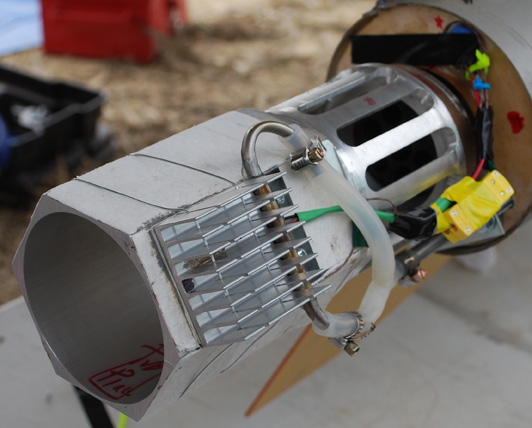Last Sunday, Vanderbilt’s Aerospace Club participated in a major NASA rocket competition at Huntsville, Alabama and came away with a first place award for their payload design.
This is the fourth year that the Vanderbilt group has been invited to the NASA Student Launch Projects rocketry challenge and the second year in a row that they have walked away with the payload prize. This year they were one of 49 student teams from 25 states that participated.

The Vandy rocket is 10.5 feet long, weighs almost 56 pounds and takes off with an impressive display of smoke and fire. It blasts up to about one mile overhead before the fuel burns out and it parachutes back to earth. The rocket is impressive, but even more impressive is the payload that it carried.
Under the supervision of Amrutur Anilkumar, professor of the practice in mechanical engineering, the rocketeers have been testing a special generator that can convert some of the waste heat from a rocket or jet engine into electricity. Why use a rocket for this purpose? It provides an inexpensive way to generate the high air speeds characteristic of airplane flight.
The basic idea is that such a thermoelectric generator could be a less expensive and more efficient way to generate the electricity that jet aircraft need to operate. Jet engines are about 50 percent efficient, meaning that half the energy in the fuel they burn ends up as waste heat. Aircraft burn fuel to drive small auxiliary generators to provide air conditioning, lighting and other similar purposes. In fact, a jumbo jet like the Boeing 747 has several generators that can churn out about 200 KW for these purposes.

When you think of a rocket payload, you generally think of a package that rides at the top of the rocket just behind the nose cone. But the thermoelectric generator actually fits on the tail of the rocket just behind the rocket motor.
Flying a payload behind the rocket engine is such a delicate task that the Vandy team is the first one to have done it. (The design has to be just right to allow the exhaust to expand or the rocket will drastically lose thrust.) “When we proposed the design, NASA cautioned that it would be too risky and told us that there had been no documented attempts at flying any payload behind a rocket,” Anilkumar said. “But the rocketeers persisted with a very careful testing protocol to arrive at the right design.”
The design they came up with is roughly cylindrical in nature. As the rocket exhaust passes through it, it heats the inside surface of the generator. The outside of generator is equipped with a number of small vanes that increase the rate at which the outside air removes heat and so keeps the outside surface cool. The temperature differential generates electrical current.
Last year, the student rocketeers showed that their design worked with the rocket, and that air speed improved its energy conversion efficiency. This year, they decided to demonstrate that it will work even better in the much different atmospheric conditions experienced by a jetliner flying at altitudes between 30,000 to 40,000 feet. First, they determined that they could simulate high altitude flight by boosting the cooling on the outer surface of the generator by spraying it with liquid nitrogen. Then they built such a cooling system for the rocket and tested it last weekend. It worked perfectly.
The thermoelectric generator not only landed the payload prize twice, but it so impressed an official at the electronics company Tektronix, Inc., that he arranged to have the company donate one of their $6,000 instruments to the team.
If the results of the rocketeers’ tests come to the attention of the right people at Boeing or Airbus or the engine makers GE or Rolls Royce, ten years from now you may see narrow black-and-gold rings attached to the back end of the turbofan engines of some of the airliners that you fly and the tickets might be several dollars less than they would be otherwise.